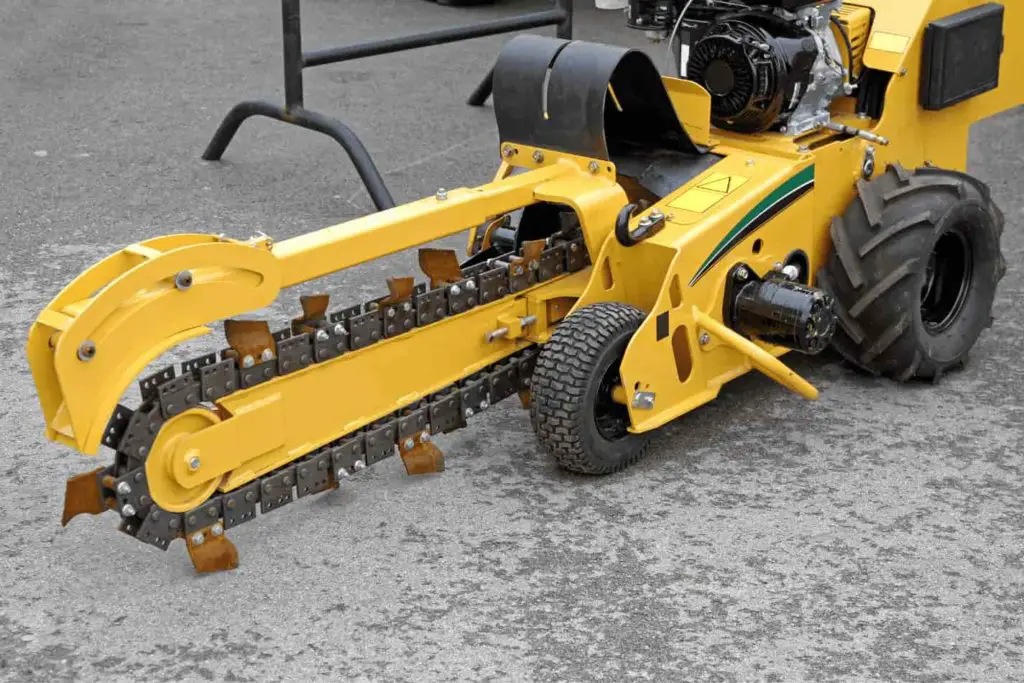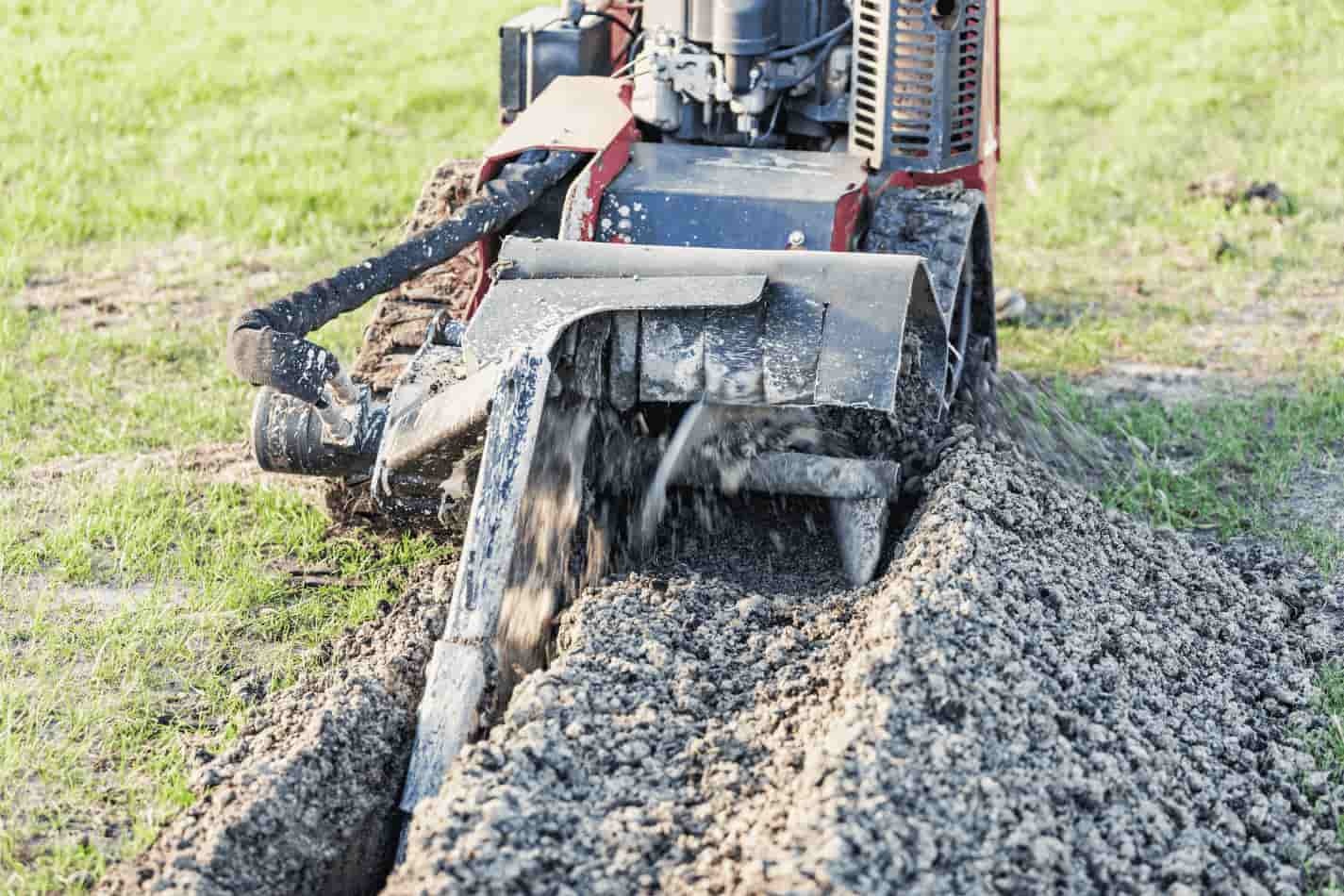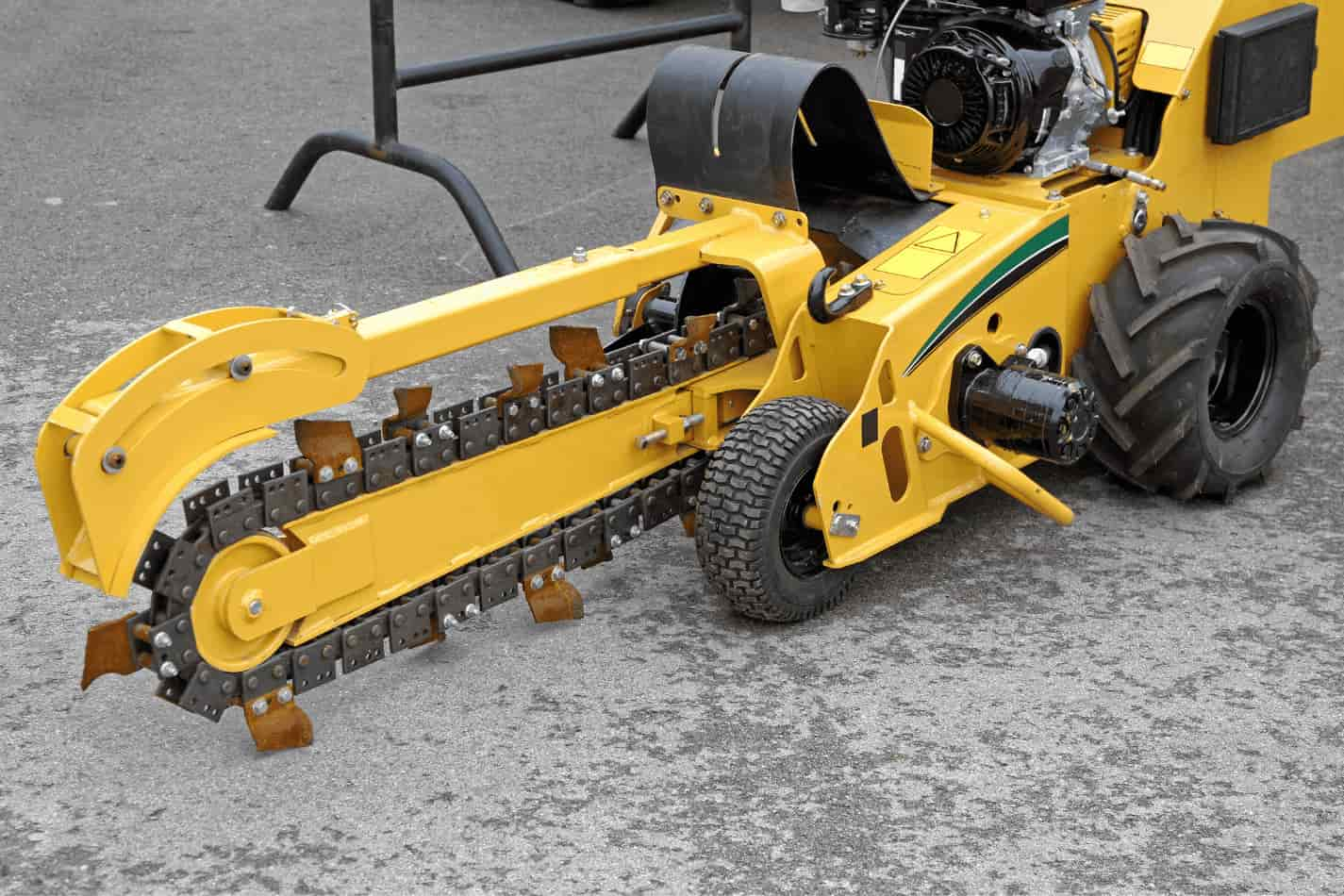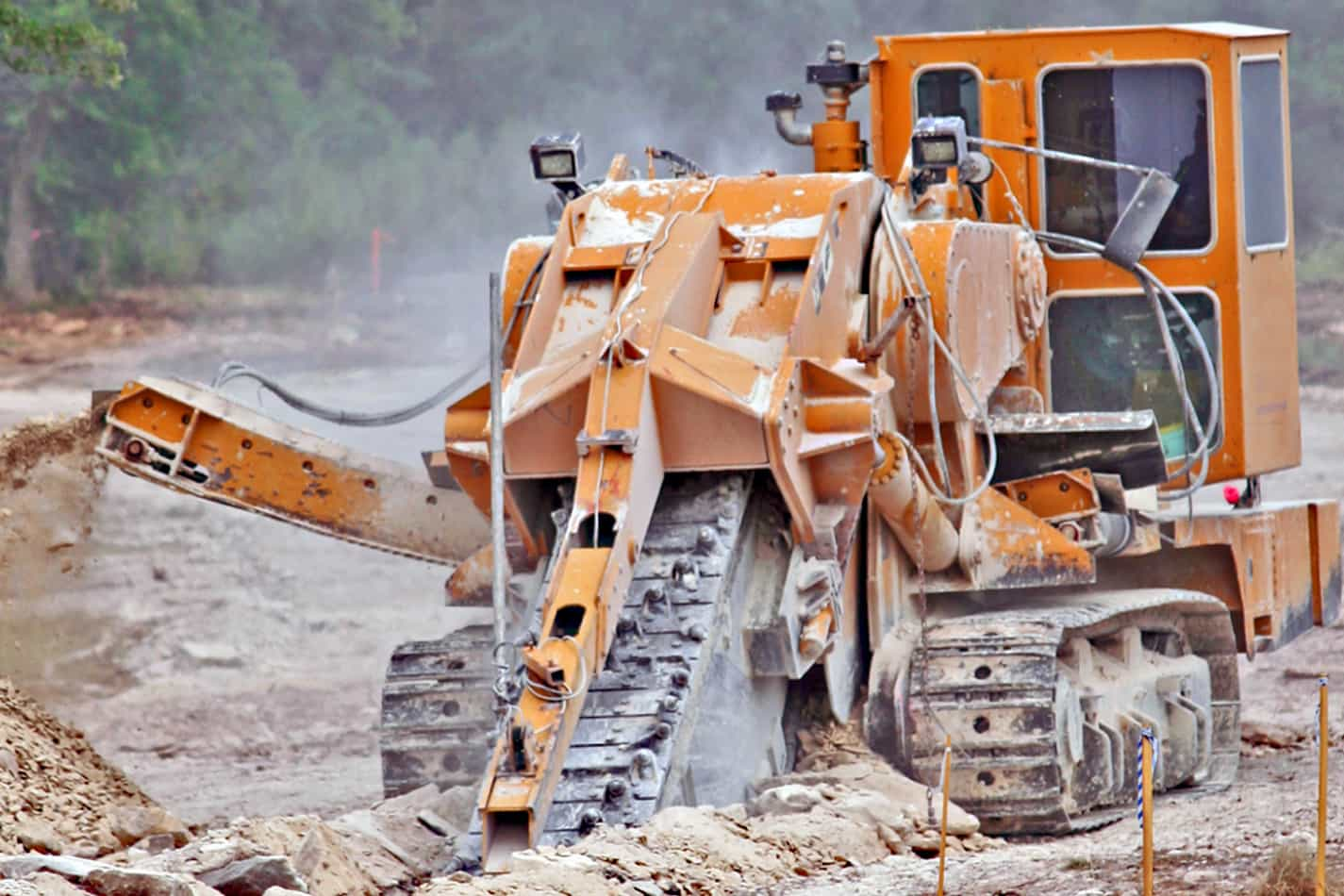If you have hilly terrain in your backyard or on your property, you may be wondering if using a trencher is still an option for your landscaping needs.
Trenchers are commonly used to dig trenches for irrigation systems, electrical wiring, and other underground utilities. However, their effectiveness on hillsides can be questionable.
While trenchers are typically designed to work on flat terrains, they can still be used on hills with some modifications and precautions.
In this article, we will discuss whether it is feasible to use a trencher on a hillside and the factors that should be considered before deciding to do so.
Let’s dive into the world of trenching and hillside landscaping!

Understanding The Terrain
Maintaining terrain stability is a crucial factor in determining whether or not a trencher can be used on a hill. The ground must be level and firm enough to support the machinery, and there should be no risk of soil erosion that could lead to landslides or other hazards.
Before attempting to use a trencher on any hilly terrain, it’s important to assess the ground conditions carefully. This involves checking the slope of the hill, as well as examining the soil composition and any natural features that might affect stability, such as rocky outcroppings or waterways.
Soil erosion is another major concern when using a trencher on a hill. If the ground is too loose or unstable, there’s a risk that digging could cause significant damage to the surrounding ecosystem.
In order to minimize this risk, it’s important to take precautions such as using sediment control devices and carefully planning out excavation sites before beginning work.
Modifying The Trencher
While it may seem daunting to use a trencher on a hill, it is definitely possible with the right equipment and modifications. One of the main concerns when working on an incline is safety, but there are measures that can be taken to minimize risks.
It is important to make sure that the trencher has proper traction and stability before beginning any work. Safety modifications such as adding stabilizing legs or using a winch system can greatly increase stability while operating on hills. Equipment adjustments like changing the angle of the blade or adjusting the depth control can also improve performance and reduce accidents.
Additionally, it is essential to have an experienced operator who knows how to handle a trencher on uneven terrain. It is also important to note that not all trenchers are created equal and some models may not be suitable for hillside work.
When choosing a trencher for this type of job, it is crucial to consider factors such as weight distribution, horsepower, and tire size. By taking these precautions and making necessary modifications, using a trencher on a hill can be both safe and efficient.
Precautions To Take
When considering using a trencher on a hill, it is essential to take certain precautions. One of the most critical precautions is proper anchoring. A trencher that is not anchored correctly can lead to dangerous accidents and damage to property. Ensure that the trencher is anchored securely before beginning any work.
Another crucial factor to consider is weight distribution. Uneven weight distribution can cause the trencher to tilt or tip over while in use, leading to significant accidents and injuries. It’s essential to ensure that the weight of the machine is evenly distributed, especially when working on steep hillsides.
Lastly, it’s crucial to be aware of your surroundings when operating a trencher on a hill. Avoid working near edges, cliffs or areas with loose soil that could cause the machine to slip or tip over.
Always wear proper safety gear such as gloves, boots, and eye protection to prevent injury.
By following these precautions, you can safely use a trencher on a hill without risking harm or damage to property. Remember always to check for proper anchorage and ensure even weight distribution before starting work. Keep an eye out for hazards in your surroundings and take necessary safety measures at all times.
Alternatives To Trenching On A Hill
Excavation can be an effective way to install utilities on a hill, but it can be time consuming and labour intensive.
Terracing is an option if the slope is too steep for a trencher, as it can help to level the area and reduce the risk of erosion.
Retaining walls are also an option, as they can help to create a flat surface and provide an anchor for the soil.
Slope grading is also a viable option, as it can help to reduce erosion and improve drainage on hilly terrain.
Excavation
When considering excavation on a hill, it’s important to take into account the slope stability and erosion control. Trenching is not always the best option for hilly terrain as it can weaken the soil and increase the risk of landslides. However, there are alternatives to trenching that can be used on hills.
One option is horizontal directional drilling (HDD), which involves drilling a hole horizontally underground and then pulling a pipe through it. This method is less invasive than trenching and can help maintain the slope stability of the hill. Additionally, HDD can be used for longer distances than trenching, making it an efficient choice for larger projects.
Another alternative to trenching is hydroseeding, which is a process of spraying a mixture of seed, mulch, and fertilizer over the topsoil to promote new growth. This method helps prevent erosion by stabilizing and protecting the soil while allowing vegetation to establish itself. Hydroseeding can also be combined with other erosion control techniques such as geotextiles or retaining walls to provide additional support for hillsides.
In conclusion, using a trencher on a hill may not always be the best choice due to concerns about slope stability and erosion control. However, there are alternatives such as horizontal directional drilling and hydroseeding that can still achieve desired results while minimizing negative impacts on the environment.
It’s important to weigh all options when planning an excavation project on hilly terrain to ensure safety and sustainability.
Terracing
Now that we have discussed the alternatives of HDD and hydroseeding, another way to prevent soil instability and erosion on hillsides is through terracing. Terracing is a method of creating flat areas on steep slopes by building retaining walls or earth embankments.
This technique not only stabilizes the soil but also provides usable space for gardening or landscaping. Terracing involves cutting into the hillside to create a series of flat steps supported by retaining walls.
These walls can be made from various materials including concrete, stone, or wood. The terraces are then filled with soil and planted with vegetation to further reinforce the slope stability and prevent erosion.
In addition to its practical benefits, terraced gardens can also add aesthetic value to a property. By incorporating different plant species and garden features such as water features or sculptures, a terraced garden can become an impressive focal point in any landscape design.
Overall, terracing is an effective method for managing erosion control and maintaining soil stability while also providing unique opportunities for creativity and design in landscaping projects.
Can a Trencher be Used to Protect Against Tornadoes?
The question of whether a trencher can be used to protect against tornadoes depends on the tornado lifting capabilities examined. Trenchers are primarily designed for digging trenches to lay utility lines or irrigation pipes. They may help divert water in case of heavy rainfall, but they cannot withstand or prevent the strong wind forces associated with tornadoes. Building dedicated storm shelters or implementing advanced tornado-resistant construction methods are more effective measures to protect against tornadoes.
Hiring A Professional For The Job
While it may be tempting to try to tackle trenching on a hill yourself, it is often best to hire a professional for the job. The pros and cons of hiring a professional versus doing it yourself should be carefully considered before making a decision.
One of the biggest advantages of hiring a professional is their expertise and experience. They have likely encountered similar situations before, and know how to handle them safely and efficiently. Additionally, they will have access to top-of-the-line equipment that may not be available for rent or sale to the general public. With their knowledge and tools, they can ensure that the job is done correctly without damaging any surrounding landscaping or structures.
When considering cost comparison, it’s important to factor in not just the initial expense of renting or buying a trencher, but also potential repairs or replacements if something goes wrong during use. On top of that, you’ll need to consider your time investment into learning how to properly operate the equipment and complete the task at hand.
Hiring a professional eliminates these extra costs and saves you time in the process. Ultimately, when it comes to trenching on a hill, hiring a professional is often the smarter choice. With their expertise, experience, and access to quality equipment, they can complete the task quickly and safely while saving you money in the long run.
Don’t risk damaging your property or injuring yourself – leave it to those who know what they’re doing.
Frequently Asked Questions
How Deep Can A Trencher Cut Into The Hillside?
When excavating a hillside, it’s essential to consider the slope stability and soil composition to ensure safe and effective digging.
The depth that a trencher can cut into a hillside depends on various factors such as the angle of the slope, soil type, and moisture content.
For instance, if the slope is too steep or unstable, it may not be safe to use a trencher.
Similarly, if the soil is too loose or rocky, it may be challenging to achieve the desired depth with a trencher.
It’s crucial to evaluate these factors before using any excavation equipment to avoid accidents or damage to the landscape.
Will A Trencher Damage The Roots Of Trees Or Other Vegetation On The Hill?
When working on a hill, it’s important to prioritize root protection and hillside stability. In fact, studies have shown that a single large tree can add up to $10,000 in value to a property. Therefore, damaging the roots of trees or other vegetation on the hill can be costly and detrimental to the overall health of the landscape.
Using a trencher on a hill may seem like an efficient way to dig trenches for irrigation or drainage systems, but it can also lead to unintended consequences. The weight of machinery and movement of soil can destabilize the slope and harm the roots of nearby plants.
To avoid this, it’s best to consult with a professional landscaper who can recommend alternative methods that prioritize root protection and hillside stability while still achieving your desired outcome.
Can A Trencher Be Used On A Steep Hill Or Only On A Gradual Slope?
Trencher stability is a critical factor when it comes to hillside excavation techniques.
A trencher can be used on a steep hill, but only if the machine is designed for such challenging terrain.
To maintain safe and stable operation, the trencher must have adequate traction and counterbalance to prevent tipping or sliding down the slope.
Additionally, the operator must have proper training and experience in using the equipment on slopes to avoid accidents and ensure effective excavation results.
By following these guidelines, you can use a trencher on a steep hill with confidence and efficiency.
Is It Necessary To Compact The Soil After Trenching On A Hill To Prevent Erosion?
Soil compaction is a crucial step in any landscaping project, especially when trenching on a hill. Failure to compact the soil after trenching can lead to erosion and other undesirable outcomes.
Compacting the soil helps to stabilize it and prevent water from washing it away. Furthermore, compacted soil provides a sturdy base for plants to grow and thrive.
Erosion control is another important aspect of trenching on a hill. It involves using various techniques such as planting ground cover or installing retaining walls to prevent soil loss due to water runoff.
By taking these extra steps, landscapers can ensure that their projects are not only visually appealing but also sustainable over the long term.
Can A Trencher Be Used To Dig Trenches For Irrigation Systems On A Hill?
As a professional landscape writer, it’s essential to consider the best excavation method for your irrigation system on a hill.
While a trencher can be an efficient tool, it’s crucial to keep up with trencher maintenance to ensure optimum performance.
However, if you’re looking for alternative hillside excavation methods, there are other options such as hydro excavation or hand digging.
These methods may take longer and require more manual labor, but they can also be less disruptive to the surrounding environment and prevent erosion.
Remember that choosing the right excavation method can make all the difference in achieving a successful irrigation system on a hill.
So, weigh your options carefully before digging in.
Conclusion
In conclusion, using a trencher on a hill is possible but requires careful consideration and planning. The depth to which the trencher can cut into the hillside depends on the slope gradient and soil stability. It is crucial to avoid damaging any trees or other vegetation that may be present on the hill.
Furthermore, compacting the soil after trenching is essential in preventing erosion and maintaining the stability of the hill.
Interestingly, according to a study by the US Environmental Protection Agency, erosion caused by land development activities accounts for up to 70% of all water pollution in American waterways. This statistic highlights the importance of taking precautions when using equipment like a trencher on hillsides to ensure minimal environmental impact.
As professional landscapers, it is our responsibility to prioritize eco-friendly practices that preserve our natural resources. While using a trencher on a hill may be necessary for some projects, we must always consider the potential impact on our surroundings and take measures to minimize any harm. By doing so, we can create beautiful landscapes while preserving our environment for future generations.





